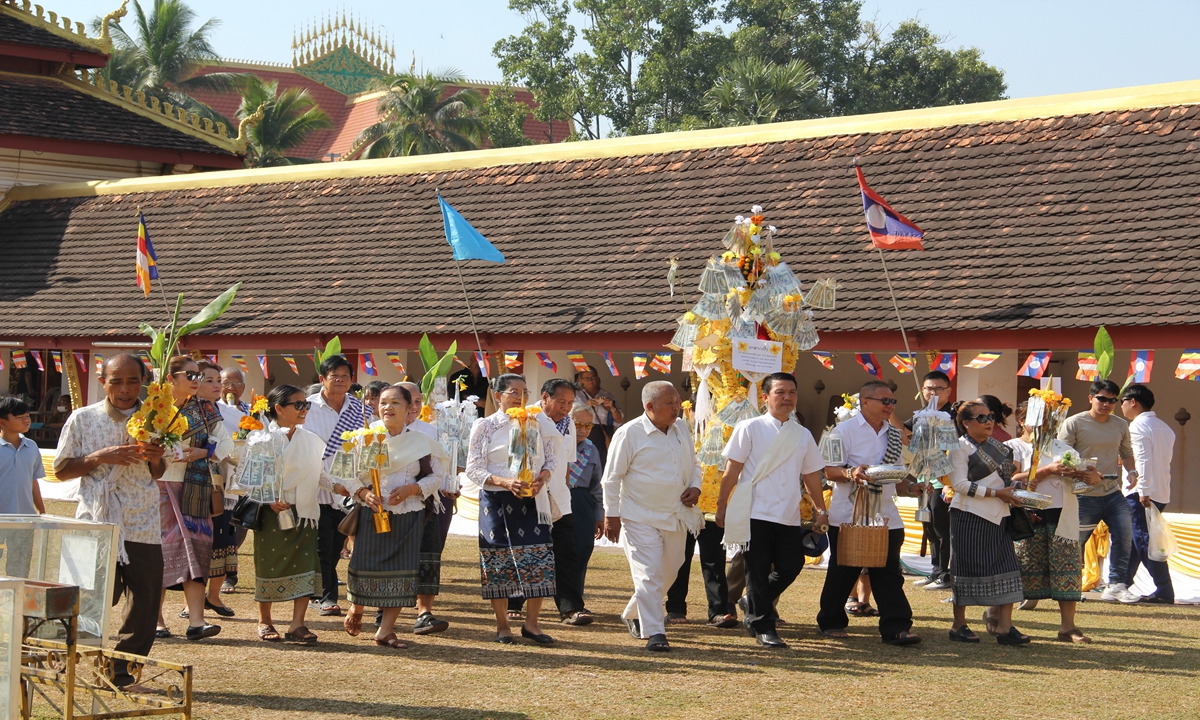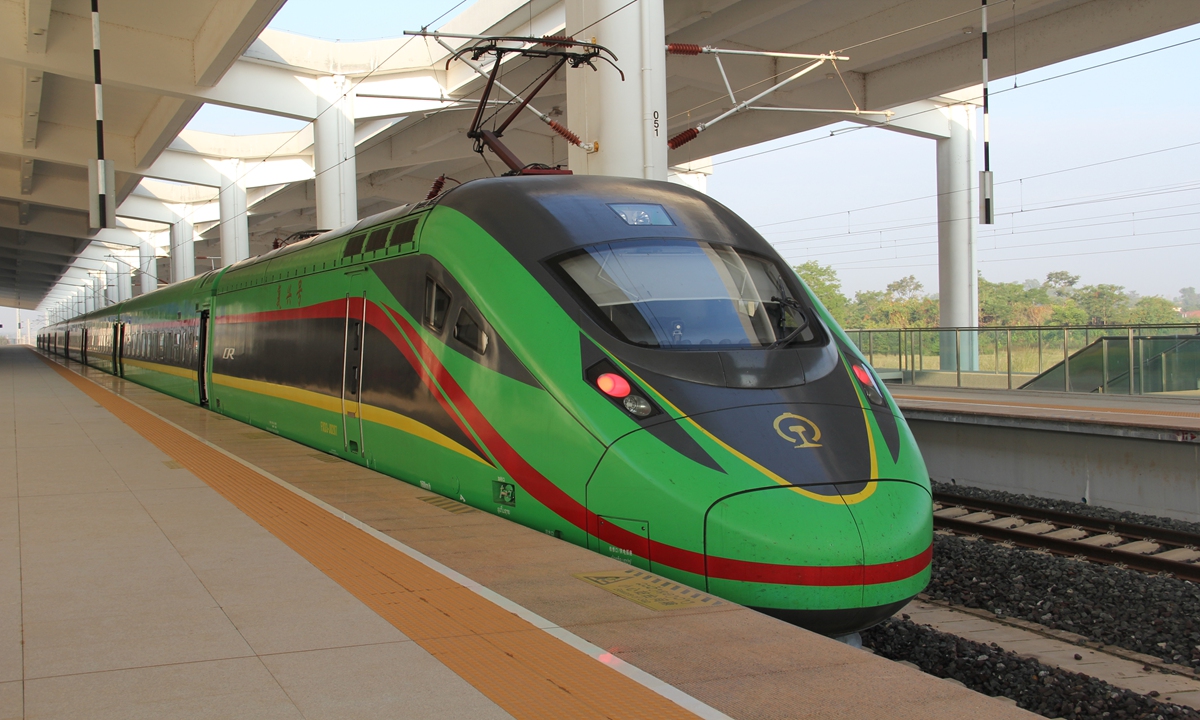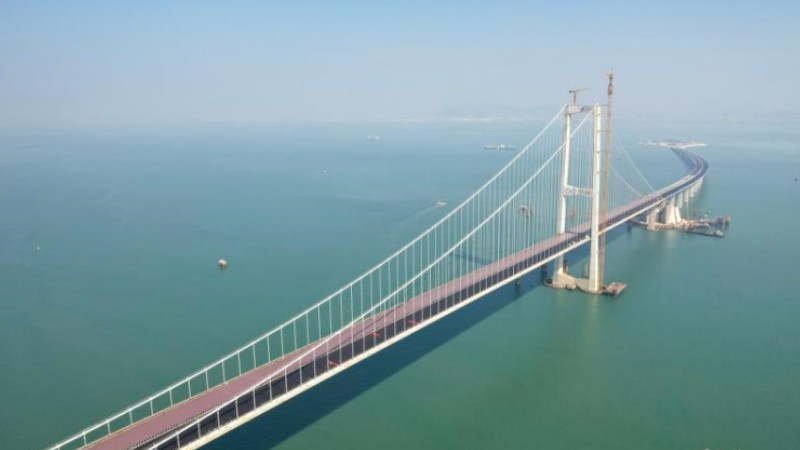China-Laos Railway brings booming tourism, business opportunities

People attend the annual That Luang Festival in That Luang Stupa in Vientiane, Laos, on November 26, 2023. Considered as the most important religious festival in Laos, the That Luang Festival, which falls from November 23 to 27 this year, was observed by Lao people from all over the country around the That Luang Stupa. The China-Laos Railway has greatly facilitated Lao people's access to scenic spots across the country. Photo: Wang Qi/GT
"Laos is one of the few countries where I'd be willing to stay for a month," said Zhang Xiaoyan, general representative of the Lao Culture and Tourism Center, during a dinner time at an open-air restaurant by the Mekong River on Monday night.
For Zhang, whose job is to build bridges between China and Laos, Laos is familiar. But for many Chinese, their land neighbor is not normally thought of as a popular destination for tourism or investment. But changes are happening with the operation of the China-Laos Railway in December 2021.
Nowadays, more and more tourists choose to take the China-Laos high speed train to visit temples and Buddha statues, and experience the slow-paced leisurely life. More and more investors have also realized the unique advantages of Laos in trade and business.
As of November 3, 2023, the China-Laos Railway has carried more than 23 million passenger trips from 70 countries and regions, and over 27.8 million tons of goods covering 12 Belt and Road Initiative (BRI) countries, including Thailand and Vietnam, according to media reports.
The Railway matters
Chansamone is a local Lao tour guide who meets the reporter. He speaks fluent Chinese and usually receives government and business delegations from China.
He told the reporter that the agency he served for, "Tiane Bang Travel" (translated as "kingdom of elephant"), normally receives at least 20 Chinese tour groups a day in the tourist cities of Vientiane and Luang Prabang.
"I started working in the tourism industry in 2014 and since the China-Laos Railway came into operation, there have been even more Chinese tourists," he said.
"The relatively lucrative industry in Laos is tourism…Ten years ago in Vientiane, there were much fewer cars on the road. Nowadays, being stuck in a traffic jam is common in Vientiane," he noted.
"The China-Laos Railway has really boosted our economy and quality of life," said Chansamone. He noted that in the past, one needed to take a bus along a mountain road for two or three days to get to Boten (a border city neighboring China), but now it only takes about four hours through the China-Laos Railway.
"The China-Laos Railway has become a tourism product itself," Zhang said, "many tourists from Thailand, Cambodia and Myanmar travel to Luang Prabang and Vang Vieng because they want to experience the China-Laos high-speed train."
Laos, which will assume the chairmanship of the ASEAN in 2024, launched Visit Laos Year 2024 tourism promotion campaign on November 23. The year 2024 also marks China-ASEAN Year of People-to-People Exchanges.
According to Zhang, there are 16 more travel agents from China's Yunnan Province that will set up branches in Luang Prabang in December.
"We always welcome Chinese tourists… We hope to see more and more Chinese tourists coming to Laos next year," Laotian Deputy Prime Minister and Foreign Minister Saleumxay Kommasith, told the Global Times, on the sidelines of an ASEAN-China forumheld on Monday in Vientiane.
The Lao government, which has made tourism a top priority in efforts to revitalize its economy, expects to attract at least 2.7 million foreign tourists in 2024, generating about $401 million in revenue. In the first nine months of 2023, Laos attracted more than 2.4 million foreign tourists, up 285 percent year-on-year, with nearly 1 million from Thailand, more than 600,000 from Vietnam and nearly 480,000 from China, according to data from Laos' tourism authority.
Inthy Deuansavanh, the chairman of the Green Discovery Laos, a renowned local travel agent on outdoor adventure, told the Global Times on Monday that Chinese tourists' potential is "very huge" regarding its population, "especially with the railway."
"I know mainstream of Chinese travel, they like shopping, they like entertaining, but I think even a smaller percentage of Chinese people like outdoor adventure, is big enough for us," said Deuansavanh.
The social platforms in Laos are different to China. He said the agent would like to invite influencers from China to visit Laos. "I think that we need to start using the Chinese platforms to promote our product."
A retired granny from Kunming, China's Yunnan Province, has chosen Laos for her first outbound trip. On Tuesday, she ended her week-long trip by taking the China-Laos high-speed railway, returning to Kunming from Vientiane. She said she was satisfied with the trip.
"I feel safe here, and prices are not too high, and now I can come to Laos more often with the high-speed railway in operation," she said.
The headquarters of the company that operates the China-Laos Railway, Laos-China Railway Co., Ltd., is located in the north-eastern part of Vientiane in the Saysettha Development Zone (SDZ).
SDZ, a Laotian special economic zone and China's national level overseas economic cooperation zone, is a successful implementation of the BRI in Laos.

A China-Laos Railway passenger train bound for the Lao's tourist destination Luang Prabang awaits departure from Lao capital Vientiane on November 28, 2023. Photo: Wang Qi/GT
Potential of economic zone
In October 2010, the SDZ was invested and constructed by Lao-China Joint Venture Investment Co., Ltd., which was jointly invested by the Yunnan Provincial Overseas Investment Co., Ltd. and Vientiane government. It was unveiled and started operation in August 2018.
Covering an area of 11.5 square kilometers, SDZ now attracted over 130 enterprises from nine countries, with more than 8,000 people work there.
About 100 Chinese business people visited SDZ on Monday, looking for business opportunities.
Huang Yuequn, a Chinese businessman from Xiamen, who is looking to invest in Laos, told the Global Times that Laos has lower labor and land costs, abundant hydropower resources, but what is more important to him is the current health and stability of China-Laos relations.
Huang is also looking forward to easier access to transport, including infrastructure in Laos and customs clearance processes, so that China's advanced management and technical personnel can come to Laos more easily.
He said that mainly he wants to enjoy the convenience brought by the China-Laos Railway, and he would consider investing in agricultural farming and minerals.
Wang Lizong, chairman of Guangdong High-tech Industry Chambers, told the Global Times that SDZ's low-labor cost and tax and tariff advantages will be further magnified if the region can further develop its entire industrial chain, from upstream and downstream.
Photos
Related Stories
- BRI brings strengthened connectivity for common development, prosperity
- Myanmar tourism chief hails BRI's role in boosting connectivity, welcomes tourists from China
- Interview: Croatian CEO seeks to deepen ties with China
- Interview: Belt & Road Initiative raises new concept for multilateral cooperation: Turkish scholar
- Kyrgyzstan premieres documentary on Belt and Road Initiative
- Symposium in Brussels marks 10 years of China's BRI
Copyright © 2023 People's Daily Online. All Rights Reserved.









